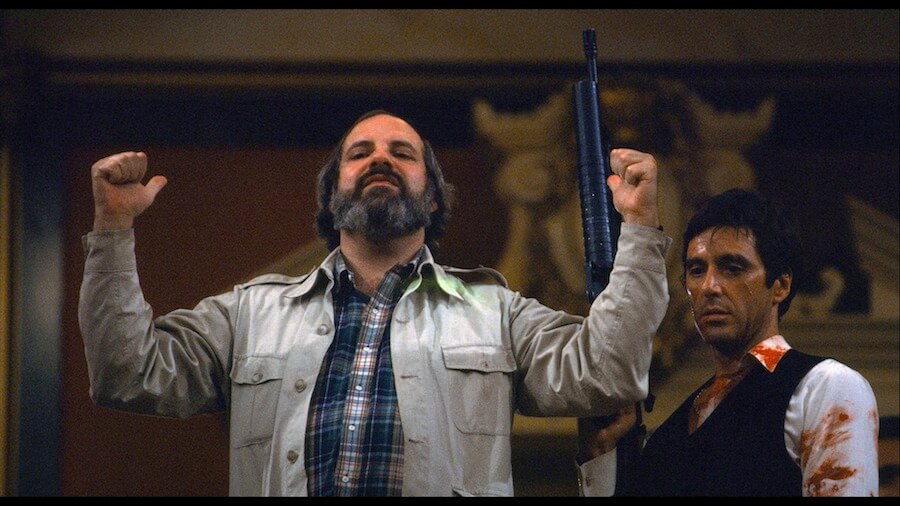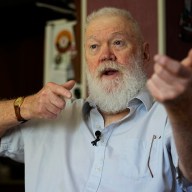‘De Palma’ The mind of Brian De Palma is a deliciously unseemly place to be, riddled with sex and blood and Hitchcock and prolonged slow-mo and split-screen mania. His work, as ever, is hotly contested, and not undeservingly. The career-spanning doc “De Palma” isn’t here to make his case. It takes as given that the creator of “Sisters,” “Carrie,” “Scarface,” “Blow Out,” “Mission: Impossible” and even “The Bonfire of the Vanities,” “Mission to Mars” and (the secretly great) “Raising Cain” is a genius. Freed from that conversation, “De Palma” gets to the business of trapping us inside his head and his work. There are no colleagues or fans trying to top each other with the juiciest hyperbole — that sordid game that typically ruins filmmaker docs and Blu-ray special features. Not even the film’s own fanboy makers, Noah Baumbach and Jake Paltrow, pipe up. RELATED:Interview: Noah Baumbach and Jake Paltrow talk “De Palma,” a film about a filmmaker The only things we see and hear are clips from De Palma’s 29 features (plus errata, like his video for Springsteen’s “Dancing in the Dark”) and the man himself, sitting in a chair, regaling us with stories. De Palma’s CV is one of hills and valleys, but each film is given equal screentime. Every film, good or bad, hit or bomb, weirdo whatzit or angry polemic, is equal now. As for De Palma himself, the occasional gripe aside, he’s in a chipper mood, no less because he’s not being badgered by critics, controversy and meddling execs. He’s allowed to live inside the vacuum he’s painstakingly created. Of course, there’s much to divine from these deceptively simple digs. It’s a kind of Rorshach movie: you see what you see, with ideas allowed to pop out organically. De Palma rarely speaks about themes or even content. He winds up mostly talking shop. Sometimes it’s shots and editing. But most of the time it’s focused on the very nuts and bolts. He talks production headaches, last-minute cast switcheroos, battles for budgets. He mostly stays away from old controversies, as today’s brouhaha is tomorrow’s footnote. RELATED:Interview: Lizzy Caplan on “Now You See Me 2” and hating the question “Are women funny?” So what do we see? An artist who’s survived in a rough business that thrives on wealth. A subversive who’s also a populist, except when he’s not. An outsider who still aligns himself with the ’70s Easy Rider/Raging Bull gods when it’s useful. He becomes a model not just of a singular artist but one who’s both stubborn and flexible, who does his thing while knowing he can’t obsessively sculpt his career. He falls into genres (horror, thrillers, space operas) by accident; he kicks off his Hollywood career by being fired off the unwieldy boondoggle “Get to Know Your Rabbit,” then is able to sneak back in by pretending to play nice, only to leave again. (Today he’s an expat, his films funded exclusively with foreign money.) As a tool, “De Palma” is likely most useful for other filmmakers. The system is different now, but the basics of his career — being open but closed, going with the flow while doing you — remain the same. But it’s also invaluable for cinephiles. It tacitly argues to be as interested in what’s off-screen as what’s on, and to move away from armchair movie watching, and its reduction of cinephilia to absolute judgments. If there’s a lesson it’s to become a more curious and active viewer. Or “De Palma” can simply be enjoyed simply as comfort food, a chance for acolytes to escape from the world for two hours — not just into one movie but into an entire life’s worth. Of course, it’s only inevitable that you’ll want to escape back to take individual titles on, one by one.
Directors: Noah Baumbach, Jake Paltrow
Genre: Documentary
Rating: R
4 (out of 5) Globes
The doc ‘De Palma’ traps us inside the head of a wild filmmaker

A24
Follow Matt Prigge on Twitter @mattprigge


















